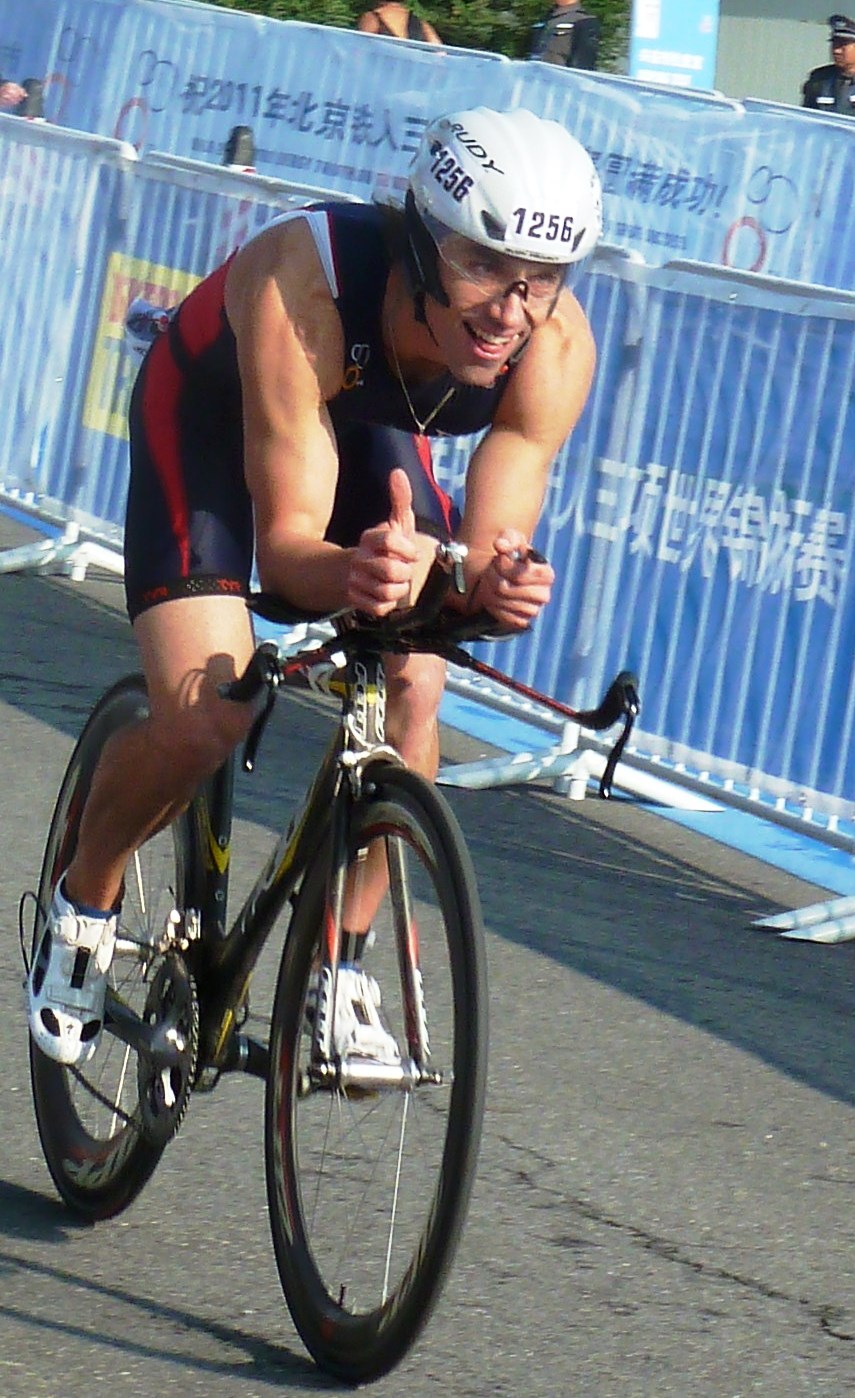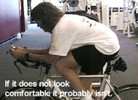To Get Fast Get Fitted bike fitting and cycling speed
Posted by Matt Russ on 30th Jan 2019
by Matt Russ (more on bike fitting services at The Sport Factory)
for Inside Triathlon magazine

A competition grade bicycle is not cheap. Once fully outfitted you will have probably spent thousands of dollars on your new pride and joy; in order to get the most value out of your investment it should fit you like a custom made glove. When fitting a cyclist the three main considerations are comfort, power production, and aerodynamics. You must choose a balance and proportion of these three elements in order to achieve your optimal fit. This proportion will be based on a variety of individual characteristics such as the type of cycling you will be engaged in, competitive level and experience, muscle imbalances and/or injury history, and your personal biomechanics and riding style to name a just a few.
Up to 80% of your aerodynamic resistance while on the bike comes from the rider- not the bike. 60% of this resistance comes from the torso alone. It is important to keep this in mind as a slightly lower torso angle will be more effective in reducing aerodynamic drag when compared to the latest and most expensive "aero" components- including the bicycle frame itself!
Comfort First
Comfort comes first, even for a competitive cyclist. If a cyclist is very uncomfortable on their bicycle they will not produce power; period. I have observed novice cyclists in very aggressive aerodynamic positions resulting in a low power output due to their discomfort. By putting them in a slightly less aggressive position they were actually faster because they could pedal harder. Comfort, of course, is relative. A time trialist must make sacrifices in comfort, but they will spend a relatively short period of time on the bike. If you are new to cycling there is a period of acclimation as your body adjusts to spending more and more time in the saddle. Some discomfort is normal, but cycling should not be painful. If you are experiencing joint, back, or neck pain it is time to look at your fit or perhaps your pedaling mechanics. Saddle soreness or numbness should be addressed immediately. These issues can often be relieved with a different saddle type or a simple adjustment that allows for correct saddle to body contact.
Type of Cycling
Next, I consider the type of riding the cyclist will do. If you are a recreational rider comfort should be your primary consideration. This means more upright, neutral, and less aerodynamic positioning. For competitive athletes power positioning and aerodynamics play a key role in fitting. Consider how much time you will be spending on your bicycle, what type of competition you will be involved in, and at what intensity you will be cycling. For example: take two hypothetical competitive triathletes, equal in all aspects with the exception that one competes in sprint events and the other in Ironman distance events. Comfort would be a greater consideration for the Ironman athlete that spends hours in the saddle whereas the sprint athlete's aerodynamics are a greater consideration for the high speeds and short durations of sprint races. For time trialists and triathletes aerodynamic positioning is key as up to 80% of cycling resistance comes from aerodynamic drag. The forearms may be four inches or more below the top of the saddle as they achieve an aerodynamic tuck. Triathletes may spend many hours in the saddle and then have to run, so this position must be less aggressive than time trialists even though they look similar. Just as each cycle sport requires a unique bicycle, each sport will have unique fit characteristics.
Riding Style
Competitive athletes must achieve the best fit for their individual riding style and to accentuate their strengths. Road racers fall on two opposite sides of the spectrum; climbers and sprinters. A pure climber prefers a level to slightly upwards saddle position, shorter stem, and wider bars. A sprinter prefers oversize handlebars that are parallel to the ground, a more forward saddle position, forward cleat position, and shorter cranks. Most road racers will be fitted somewhere in the middle of this spectrum. How you adjust your bicycle for your riding style can be a process of trial and error. Before you move or change a component, carefully mark and measure it's previous position and be sure to make small adjustments only. If you are comfortable, but would like to lower your aerodynamic profile, gradually lower your handlebar position over time and allow your body to adjust to it.
Biomechanics
The fact that every person is unique does not make bike fitting easy. Some are bow-legged or duck-footed. Torso length, leg length, and arm length all vary from person to person and in proportion to each other, and sometimes vary from left to right on the same person. Backs can be rounded, swayed, or curved, and hips vary in widths. The bottom of the foot may angle inwards or outwards. It is not always appropriate to adjust your bicycle in consideration of a biomechanical condition, and knowing when and how takes a great deal of expertise. For example: a cyclists that is "ankling" or using the right foot to pedal may be compensating for a left leg discrepancy. This may require specific shims or spacers to correct and special equipment to determine. If you believe you have a condition that affects your cycling it is best to seek a professional who is trained and familiar with biomechanical positioning.
Muscle Imbalances, Inflexibility, and Injuries
When you are injured, your body compensates for the injury by using different muscles to do the work of the ones in the injured area. Even after the injury heals you may continue to work in a compensatory fashion. This may be habitual and can cause a variety of problems with pedaling mechanics. Tight hamstrings can lead to lower back problems on the bike, and cycling in general can lead to muscle imbalance over time. Again, it takes a professional to diagnose and correct these issues. This may mean adjusting your fit to a more neutral position while the area is stretched or strengthened. If you are experiencing an overuse injury a professional may be able to adjust your fit to alleviate it entirely.
Form
Carefully observing how a cyclists looks on the bike is the best way to determine what needs to be changed. I use a stationary trainer and video for this. I shoot the cyclist from a variety of angles and then play it back in slow motion for both of us to observe. I also use a power meter to help determine if a new position resulted in a loss of power. This type of feedback is invaluable.
Often what is causing the rider discomfort or power loss is not the fit, but a correctable bad habit. It is important to make this distinction. For example: if the cyclist is complaining of elbow pain and trapezious discomfort it could be caused by using a tight, straight arm versus the slight bend required to absorb road shock, or it could be caused by a stem that is too long.
Getting the Right Fit
Start your fit by purchasing the right bike for your size. This may mean doing some research on your own or going to a reputable bike shop. Each manufacturer measures frames differently and the frames themselves can vary widely. It is important to know the manufacturers guidelines for frame size to your height and inseam. That great deal on the used bike you purchased may not seem so great when you find out it is the wrong frame size.
There are a wide variety of fitting systems that use ratios, formulas, algorithms, fit bikes, computer programs, etc.. These are even available online and each of these has its pros and cons. The most important thing to remember is that every fitting system simply gives you a starting point. No computer can tell you how your bike should optimally fit because no computer knows your riding style, biomechanics, injury history, etc.. This is where the art of bike fitting begins and it requires interaction (listening) with of the athlete. I use a variety of methods in fitting a cyclist, but my favorite tool is a simple device called a goniometer that measures joint angles.
If you are experiencing joint pain or have an overuse injury, do not wait for it to go away. Get some trained, professional eyes on you. A good bike fitting may cost well over $100 per hour but it is money well spent if it keeps you on the road and pain free or makes you a faster cyclist.


